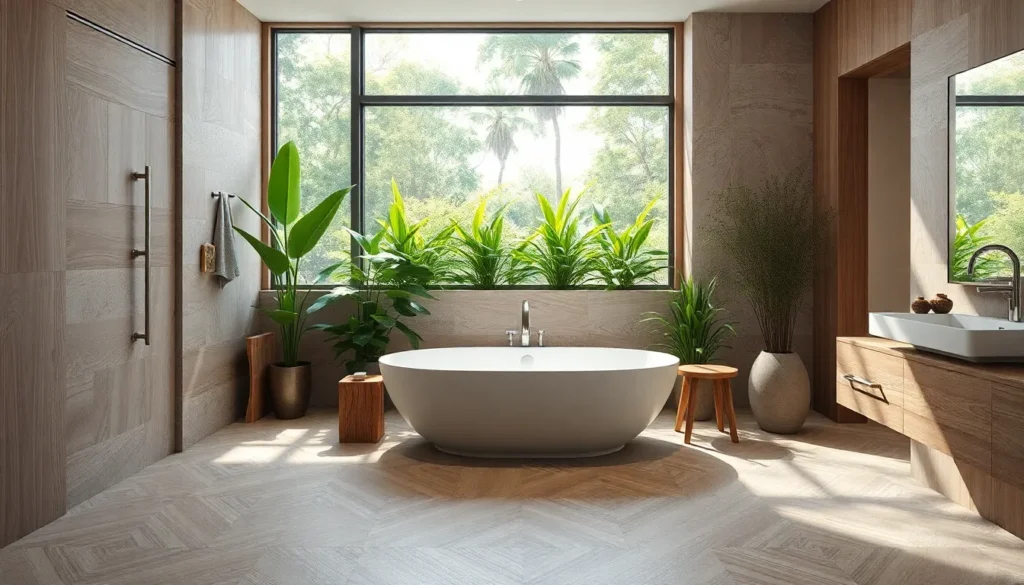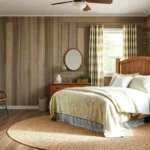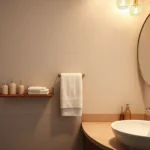Choosing the right bathroom flooring transforms your space from ordinary to extraordinary. We’ve all stood in outdated bathrooms wondering how different flooring could completely change the room’s look and feel. The perfect floor doesn’t just look amazing – it handles moisture like a champion while providing the safety and comfort your family needs.
Today’s bathroom flooring options go far beyond basic ceramic tiles. We’re seeing stunning luxury vinyl that mimics hardwood, elegant natural stone that creates spa-like retreats, and innovative materials that combine beauty with incredible durability. Whether you’re planning a complete renovation or simply updating worn floors, the right choice sets the foundation for your dream bathroom.
We’ll explore the most popular flooring materials that deliver both style and performance. From budget-friendly options that look expensive to premium choices that last for decades, you’ll discover flooring answers that match your vision and budget perfectly.
Ceramic and Porcelain Tile: The Classic Choice for Bathroom Floors
Ceramic and porcelain tiles remain the gold standard for bathroom flooring, delivering unmatched reliability and timeless appeal. We’ve seen these materials dominate bathroom renovations for decades because they perfectly balance performance with aesthetic flexibility.
Water-Resistant Properties and Durability Benefits
Porcelain tiles offer superior water resistance compared to standard ceramic options, making them our top recommendation for high-moisture environments. These dense tiles absorb less than 0.5% of water, preventing damage from splashes and humidity that plague other flooring materials.
Ceramic tiles provide excellent durability for bathroom applications, withstanding daily foot traffic and maintaining their appearance for 15-20 years with proper installation. We’ve observed that glazed ceramic surfaces resist stains and scratches better than many natural stone alternatives.
Both materials handle temperature fluctuations exceptionally well, preventing cracks and warping that can occur with extreme weather changes. Porcelain’s manufacturing process creates a harder surface that rates 8-9 on the Mohs hardness scale, making it nearly impervious to chips and wear.
Design Versatility From Subway to Mosaic Patterns
Subway tiles create clean, classic lines that complement both traditional and contemporary bathroom designs, available in sizes ranging from 3×6 inches to oversized 4×12 inch formats. We love how these rectangular tiles can be arranged in herringbone, vertical stack, or traditional brick patterns to add visual interest.
Mosaic patterns offer unlimited creative possibilities through small tile formats like penny rounds, hexagons, and intricate geometric shapes. These designs work particularly well as accent walls, shower niches, or decorative borders that break up larger tile installations.
Large format tiles (12×24 inches or bigger) minimize grout lines and create a seamless, spa-like appearance that makes small bathrooms feel more spacious. Wood-look porcelain planks bring warmth and natural texture without the maintenance concerns of actual hardwood in wet areas.
Installation and Maintenance Considerations
Professional installation ensures proper waterproofing with cement backer boards and appropriate sealers, preventing moisture penetration that leads to costly repairs. We recommend budgeting $3-8 per square foot for quality installation depending on tile complexity and regional labor costs.
Daily maintenance requires only regular sweeping and mopping with pH-neutral cleaners, making ceramic and porcelain tiles incredibly low maintenance compared to natural stone options. Grout cleaning every 6-12 months keeps the installation looking fresh and prevents mold growth in high-humidity conditions.
Repairs typically involve replacing individual damaged tiles rather than entire sections, keeping long-term costs minimal compared to sheet flooring materials. Quality tile installations can last 20-30 years with minimal maintenance, providing excellent return on investment for bathroom renovations.
Luxury Vinyl Plank: Modern Style Meets Practical Function
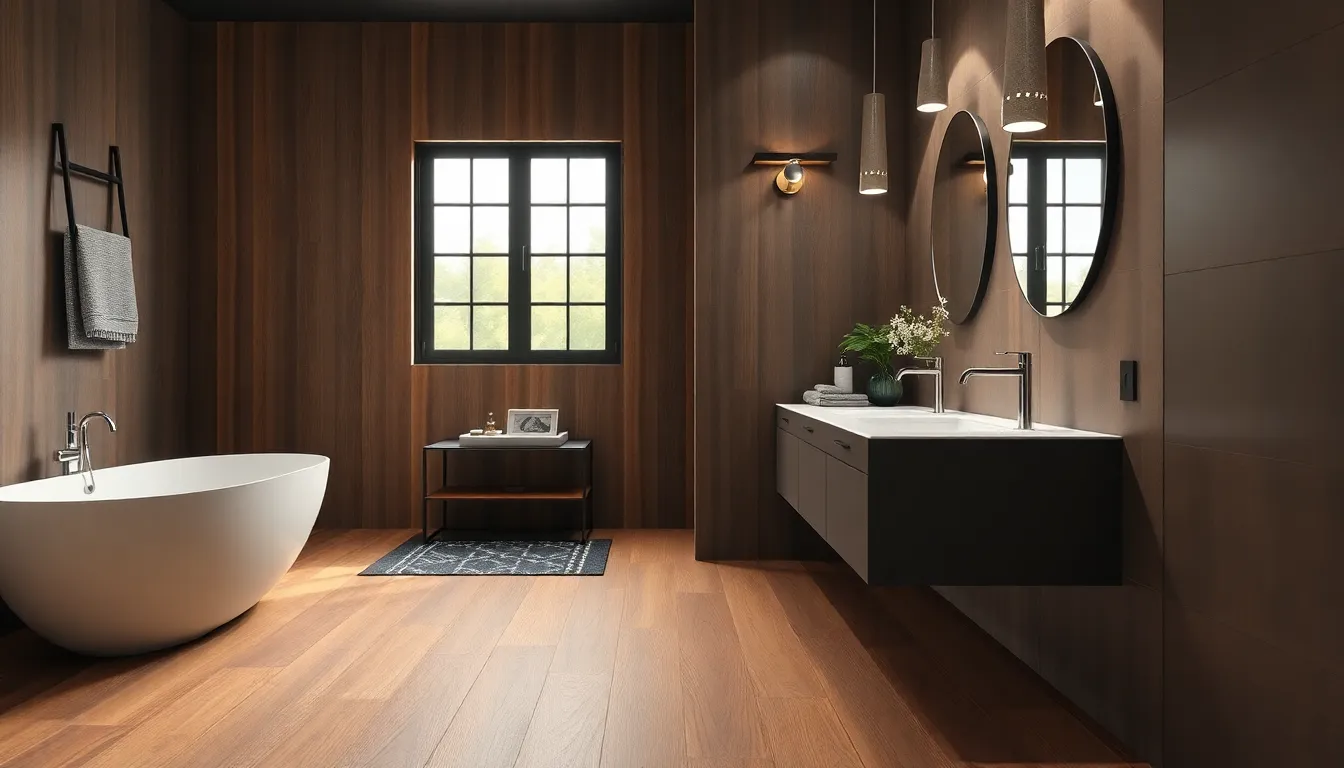
When seeking a flooring solution that combines aesthetic appeal with practical performance, luxury vinyl plank (LVP) stands out as a top choice for bathroom renovations. This versatile flooring option delivers the sophisticated look of premium materials while addressing the unique challenges that bathroom environments present.
Waterproof Technology and Comfort Underfoot
Waterproof core technology makes LVP exceptionally well-suited for bathroom installations where moisture exposure is constant. Unlike traditional hardwood that can warp or swell when exposed to humidity, LVP maintains its structural integrity even in high-moisture environments. The advanced waterproof barrier prevents water from penetrating the flooring surface, ensuring long-term durability and performance.
Comfort underfoot sets LVP apart from harder flooring materials like ceramic or stone tiles. The softer surface feels warm and cushioned, making it pleasant to walk on during early morning routines or late-night visits. Scratch resistance and stain protection further enhance its practical benefits, allowing the flooring to maintain its appearance even though daily wear and exposure to bathroom products.
Wood-Look and Stone-Look Design Options
Wood-look designs in LVP capture the natural beauty of hardwood without the maintenance concerns that come with authentic timber in wet environments. These planks replicate the grain patterns, textures, and color variations found in popular wood species, creating a warm and inviting atmosphere in your bathroom space.
Stone-look varieties offer another compelling design direction, mimicking materials like marble, travertine, and slate with remarkable authenticity. The visual depth and texture of these designs provide the luxurious appearance of natural stone while delivering the practical benefits that make LVP suitable for bathroom use. Both design categories allow you to achieve your desired aesthetic without the high costs associated with genuine natural materials.
Budget-Friendly Installation Process
Installation simplicity makes LVP an attractive option for both DIY enthusiasts and professional contractors. Click-lock systems and adhesive backing options enable straightforward installation without the need for specialized tools or extensive preparation work that other flooring types require.
Cost savings become important when considering the reduced labor expenses associated with LVP installation. Many homeowners can complete the installation process themselves, though we recommend professional installation for complex layouts or larger bathroom spaces to ensure optimal results. The streamlined installation process means less disruption to your daily routine and faster project completion compared to traditional tile installations.
Natural Stone Flooring: Elegant Options for Upscale Bathrooms
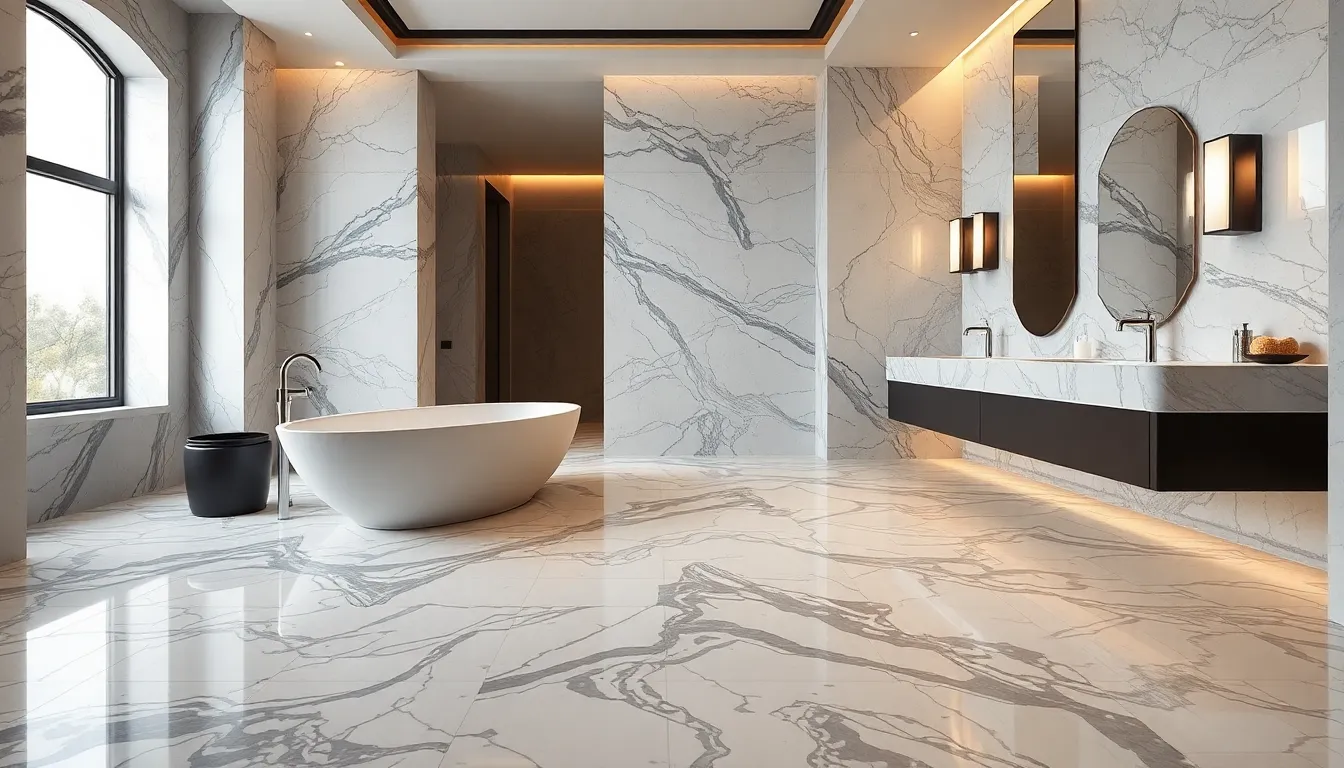
Natural stone elevates bathroom design to luxury levels with its inherent beauty and distinctive character. Premium materials like marble, travertine, and limestone create sophisticated spaces that reflect timeless elegance.
Marble Flooring for Timeless Sophistication
Marble stands as the ultimate choice for creating luxurious bathroom environments with its distinctive veining patterns and sophisticated color range. Each slab features unique natural patterns that add character and visual interest to any space. Classic white Carrara marble remains popular for its clean appearance, while dramatic Calacatta marble offers bold veining for statement floors.
Colors range from pristine whites to rich grays, providing options that complement various design aesthetics. But, marble’s softer composition makes it prone to scratches and etching from acidic substances like cleaning products or personal care items. Regular maintenance becomes essential to preserve its appearance, including professional sealing and careful cleaning with pH-neutral products.
Travertine and Limestone Alternatives
Travertine delivers rustic charm with its naturally porous surface and subtle color variations that create texture and visual depth. This Mediterranean-inspired stone features holes and pits that give it distinctive character, though these can be filled for smoother surfaces. Earth tones from cream to walnut brown offer versatility for both traditional and contemporary bathroom designs.
Limestone provides warmth and natural beauty with its earthy appearance and unique fossil patterns that tell geological stories. Many limestone varieties showcase embedded shells and marine fossils, adding conversation-worthy details to bathroom floors. Softer color palettes in beiges, grays, and taupes create calming environments perfect for spa-like retreats.
Both materials require regular sealing due to their porous nature, making them more maintenance-intensive than harder stones like granite or slate.
Sealing Requirements and Long-Term Care
Sealing becomes critical for natural stone bathroom floors, with annual applications recommended to protect against moisture penetration and staining. Professional-grade sealers create protective barriers that prevent water damage while allowing the stone to breathe naturally. Most installations require initial sealing followed by yearly maintenance to preserve the stone’s integrity and appearance.
Proper care involves using stone-exact cleaners rather than acidic products that can damage surfaces over time. Daily maintenance includes wiping up spills immediately and avoiding harsh chemicals that strip protective seals. Deep cleaning should occur monthly using pH-neutral products designed specifically for natural stone surfaces.
Long-term durability depends on consistent maintenance practices, with properly cared for natural stone floors lasting decades while maintaining their original beauty and value.
Heated Flooring Systems: Comfort-First Bathroom Solutions

Stepping onto a warm bathroom floor transforms your morning routine from a jarring experience into a luxurious start to the day. We’re seeing more homeowners embrace heated flooring as the ultimate upgrade that combines comfort with energy efficiency.
Radiant Heat Benefits for Cold Bathroom Floors
Comfort becomes the defining feature when we install heated floors beneath your bathroom flooring. Daily routines feel more enjoyable when you’re walking on consistently warm surfaces rather than shocking your feet with cold tiles. Radiant heating creates a cozy environment that makes spending time in your bathroom genuinely pleasant.
Even heat distribution sets radiant systems apart from traditional heating methods that create hot and cold spots throughout the room. Heat sources positioned beneath your flooring ensure constant warmth across every square foot of your bathroom floor. Temperature consistency means you’ll experience the same comfort level whether you’re stepping out of the shower or moving around during your morning routine.
Energy efficiency improves when radiant heat warms people and objects directly rather than heating air that quickly escapes through ventilation. Lower operating temperatures achieve the same comfort levels as conventional heating systems. Reduced energy consumption translates to lower utility bills while maintaining your desired comfort level.
Electric vs Hydronic Heating System Options
Electric floor heating systems use thermal mats or individual heating cables to generate warmth beneath your bathroom flooring. Thermal mats work best for standard rectangular spaces because they’re cost effective and easy to install in regular layouts. Individual heating cables offer flexibility when you’re working with irregular bathroom shapes or need to navigate around fixtures and obstacles.
Quick heating response makes electric systems ideal for bathrooms where you want instant warmth rather than waiting for the system to reach operating temperature. Installation complexity remains minimal since electric systems don’t require extensive plumbing modifications to your existing bathroom setup.
Hydronic floor heating systems circulate heated water through PEX tubes installed beneath your bathroom flooring. Higher upfront costs reflect the complex installation process that involves connecting to your home’s water heating system. Long term energy consumption often proves lower than electric systems because water retains heat more efficiently than electric elements.
Complex setup requirements mean hydronic systems work best during major bathroom renovations when you’re already modifying plumbing and flooring systems. Larger bathroom spaces benefit most from hydronic heating because the energy savings become more important over time.
Installation Costs and Energy Efficiency
| System Type | Installation Cost | Long-term Energy Use | Best Application |
|---|---|---|---|
| Electric | Lower upfront investment | Higher ongoing costs | Smaller bathrooms, retrofits |
| Hydronic | Higher initial expense | Lower energy consumption | Larger spaces, new construction |
Installation costs favor electric systems because they require less complex setup and fewer modifications to existing bathroom infrastructure. Electric heating elements install directly beneath most flooring types without extensive plumbing work. Professional installation typically costs less due to shorter project timelines and simpler material requirements.
Hydronic systems demand higher upfront investment because installation involves connecting to water heating systems and running PEX tubing throughout your bathroom floor area. Complex setup procedures require more specialized labor and longer project completion times.
Energy efficiency calculations show hydronic systems consuming less energy over time because heated water transfers warmth more effectively than electric heating elements. Larger bathroom spaces see the most important energy savings because the system operates more efficiently across greater square footage. Electric systems work best in smaller bathrooms where quick heating response outweighs long term energy considerations.
Cost effectiveness depends on your bathroom size and usage patterns rather than simply comparing installation prices between system types.
Waterproof Laminate: Affordable Wood-Look Alternatives
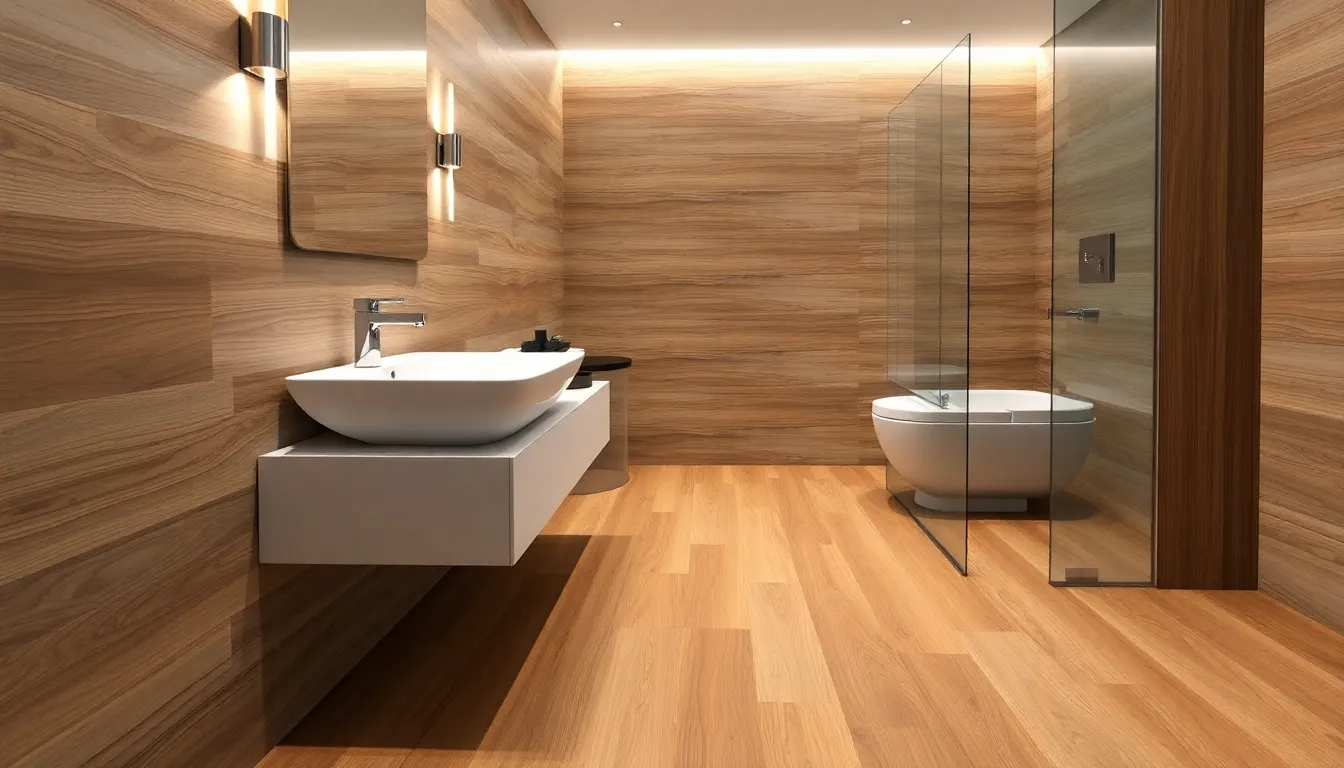
Waterproof laminate flooring offers an exceptional balance of style and functionality for bathroom renovations. This innovative flooring solution delivers the natural beauty of hardwood at a fraction of the cost while providing superior moisture protection.
Advanced Waterproof Core Technology
Modern waterproof laminate flooring features sophisticated moisture resistant core technology that makes it ideal for high moisture environments like bathrooms. The advanced core construction prevents water from seeping between planks through its tight locking system design. Engineering breakthroughs in laminate manufacturing have created products that can withstand bathroom humidity and water spills without warping or damage. Unlike traditional laminate flooring, these waterproof versions maintain their structural integrity even when exposed to standing water for extended periods.
Realistic Wood Grain Textures and Colors
Today’s waterproof laminate flooring showcases incredibly realistic wood grain textures and colors that rival the appearance of natural hardwood. Manufacturers use high definition printing technology to capture authentic wood patterns, knots, and color variations found in real timber. Popular options include oak, hickory, and maple designs that bring warmth to bathroom spaces without the maintenance concerns of actual wood. The surface textures feel authentic underfoot while providing the slip resistance needed in wet bathroom conditions.
DIY-Friendly Installation Methods
Installation of waterproof laminate flooring is remarkably straightforward thanks to its floating floor system that doesn’t require securing to the subfloor. The click lock mechanism allows planks to snap together easily, making it an excellent choice for DIY enthusiasts looking to save on installation costs. Most homeowners can complete a bathroom floor installation in a single weekend using basic tools like a saw, spacers, and a tapping block. Professional installation remains an option for those who prefer expert handling, but the simplified process significantly reduces labor costs compared to traditional tile installations.
Concrete Flooring: Industrial Chic for Contemporary Bathrooms

Concrete flooring brings an edgy, modern aesthetic to bathroom spaces while offering exceptional durability. This versatile material transforms ordinary bathrooms into stylish retreats with its clean lines and industrial appeal.
Polished Concrete Finishing Techniques
Honed finishes create a smooth, matte surface that’s perfect for minimalist bathroom designs. This technique produces a subtle sheen without the high gloss of polished surfaces, making it ideal for contemporary spaces where understated elegance matters.
Polished finishes deliver a mirror-like surface that reflects light beautifully throughout the bathroom. The grinding and polishing process creates different levels of sheen, from satin to high-gloss, allowing you to customize the final appearance based on your design vision.
Matte finishes provide excellent slip resistance while maintaining the industrial aesthetic concrete offers. These surfaces feel smooth underfoot yet offer better traction than highly polished alternatives, making them practical for wet bathroom environments.
Staining and Coloring Customization Options
Chemical stains penetrate deep into concrete surfaces, creating rich, variegated colors that won’t fade or wear away. These acid-based answers react with minerals in the concrete to produce earth tones like browns, greens, and blues that complement bathroom fixtures perfectly.
Integral pigments mix directly into the concrete before pouring, ensuring consistent color throughout the entire slab. This method prevents chipping or scratching from revealing different colored layers underneath, maintaining your bathroom’s appearance for decades.
Dye applications offer vibrant color options including bold blues, warm grays, and sophisticated charcoals. These penetrating dyes create uniform colors that work especially well in modern bathroom designs where consistent hues enhance the overall aesthetic.
Slip-Resistance and Durability Features
Textured coatings add grip to smooth concrete surfaces without compromising the industrial look. These specialized treatments create microscopic texture that prevents slipping while maintaining the sleek appearance concrete floors provide.
Specialized sealants protect concrete from moisture penetration and staining while improving durability. High-quality sealers create a barrier that repels water, soap residue, and cleaning products, extending the life of your bathroom flooring significantly.
Anti-slip additives incorporate directly into the concrete mix or topical treatments, providing long-lasting traction. These materials include fine aggregates or polymer beads that create safe walking surfaces without detracting from the smooth, contemporary appearance concrete offers.
Penny Tile and Mosaic: Creative Pattern Possibilities
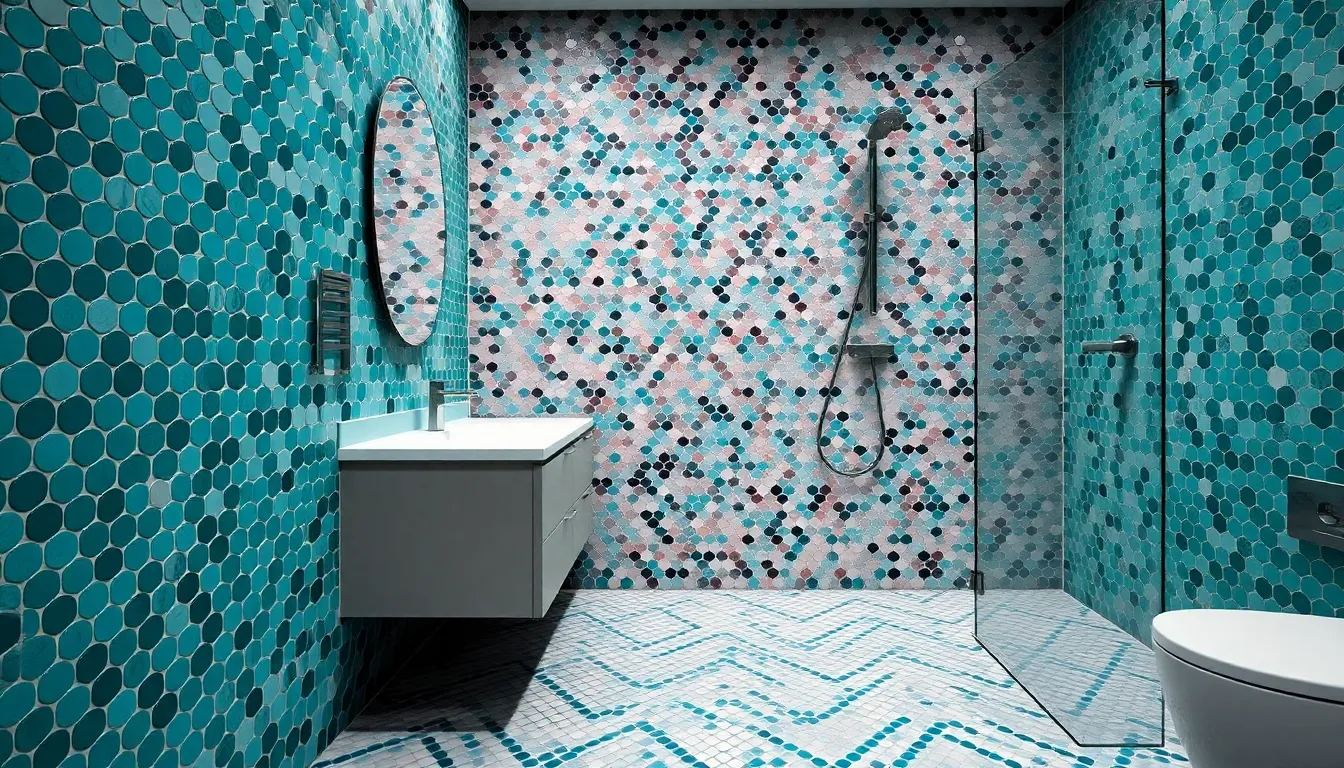
We’ve explored traditional flooring materials, but penny tiles and mosaics open up exciting design possibilities that transform ordinary bathrooms into artistic spaces. These small format tiles offer endless creative potential for homeowners seeking unique, personalized bathroom floors.
Small-Scale Tile Benefits for Bathroom Design
Enhanced slip resistance comes naturally with small tiles due to their increased grout lines, creating better traction in wet bathroom environments. Installation becomes easier on curved surfaces and around fixtures like toilets and vanities, allowing for seamless transitions between different bathroom zones.
Improved drainage occurs in shower areas where multiple grout lines channel water more effectively toward floor drains. Flexibility for intricate designs means we can create custom patterns that aren’t possible with larger format tiles.
Better conformity to irregular surfaces makes penny tiles ideal for older homes where floors may not be perfectly level or square.
Color Combinations and Layout Patterns
Bold jewel tones are driving 2025 bathroom flooring trends, with deep blue, terra-cotta red, and darker yellows replacing neutral palettes for more immersive spaces. Mixed shape formats combine penny rounds with hexagons or subway tiles to create ever-changing visual interest.
Classic patterns like herringbone and checkerboard layouts work beautifully with penny tiles, while decorative borders can define exact areas within the bathroom. Geometric arrangements using contrasting colors create focal points that draw the eye and add personality to the space.
Oversized tile formats paired with small mosaic accents provide balance and prevent busy patterns from overwhelming the room.
| Pattern Type | Best Application | Visual Impact |
|---|---|---|
| Herringbone | Shower floors | High |
| Checkerboard | Accent borders | Medium |
| Geometric | Feature walls | High |
| Abstract | Large floor areas | Variable |
Grout Selection and Maintenance Tips
Grout color selection dramatically affects the overall appearance of your penny tile installation. Lighter grout creates seamless, subtle effects that make small spaces appear larger, while darker grout highlights individual tile patterns and provides superior stain resistance.
Sealed grout prevents moisture absorption and mold growth, which is essential in bathroom environments. Regular cleaning with pH neutral detergents maintains both safety and aesthetics without damaging the grout lines.
Prompt repairs of cracked grout prevent water infiltration that can damage subflooring and create costly problems. We recommend inspecting grout lines quarterly and addressing any issues immediately to maintain the integrity of your tile installation.
Cork Flooring: Eco-Friendly and Comfortable Options
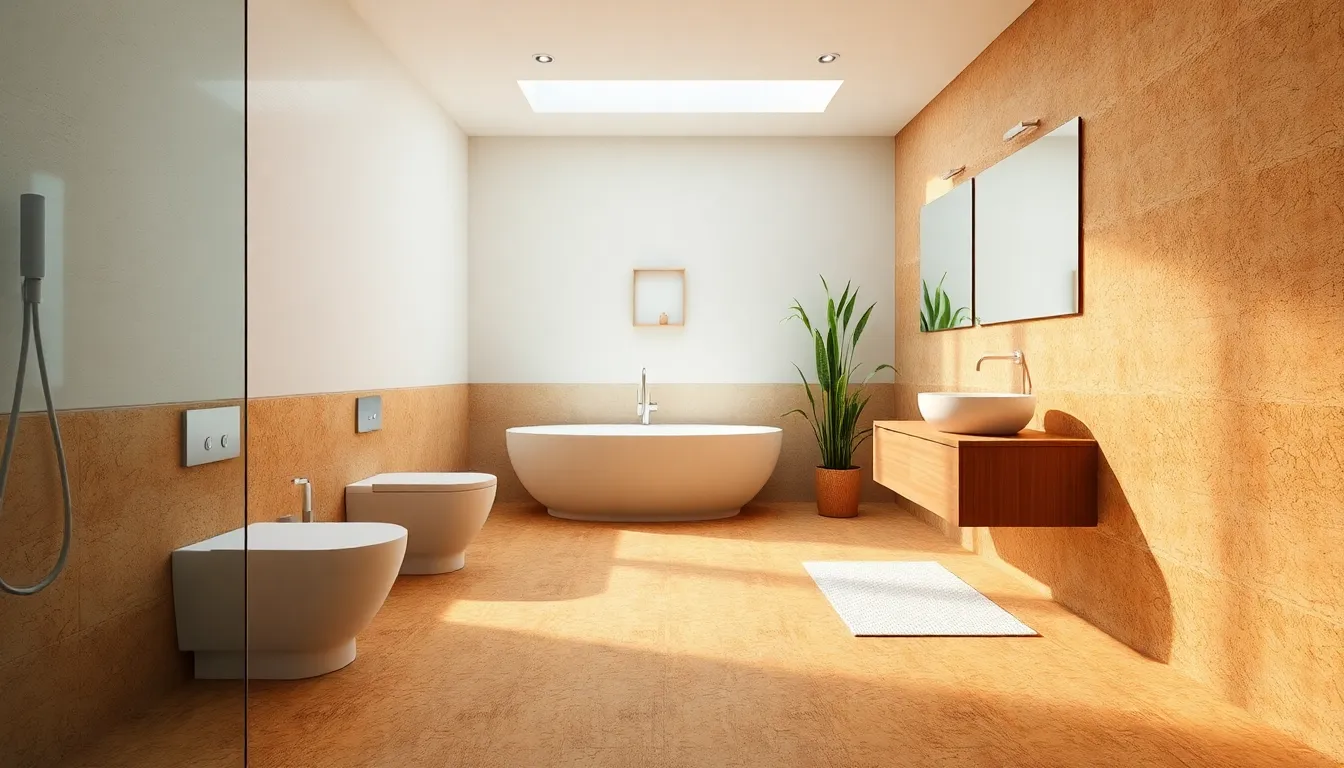
Cork flooring offers a sustainable alternative that brings warmth and comfort to bathroom spaces. This renewable material harvested from cork oak trees provides unique benefits that make it an attractive choice for environmentally conscious homeowners.
Natural Antimicrobial and Insulation Properties
Cork’s natural antimicrobial properties make it an excellent choice for bathroom environments where hygiene is paramount. The material naturally inhibits the growth of mold, mildew, and bacteria, creating a healthier indoor environment without requiring chemical treatments. This inherent resistance to microorganisms helps maintain cleaner surfaces and reduces the need for harsh cleaning products.
The insulation capabilities of cork flooring provide year-round comfort in bathroom spaces. Cork acts as an effective thermal insulator, maintaining warmth during cooler seasons and creating a comfortable surface for bare feet. Also, cork’s natural elasticity provides a soft, cushioned feel underfoot, making it particularly comfortable for extended standing periods during morning routines.
Sound dampening represents another important advantage of cork flooring. The material effectively reduces noise transmission between floors, creating quieter bathroom environments and minimizing disturbances to adjacent rooms or lower levels.
Sustainable Manufacturing and Installation
Cork flooring production follows environmentally responsible practices that minimize ecological impact. Most manufacturers use energy-efficient processes and incorporate recycled materials alongside renewable cork harvesting methods. The bark harvesting process doesn’t harm the cork oak trees, allowing them to regenerate their bark naturally over time.
Installation options for cork flooring accommodate both professional and DIY approaches. Cork tiles and planks are available in easy-to-lay systems that simplify the installation process. The straightforward installation typically requires basic tools and can be completed by experienced DIYers, though professional installation ensures optimal results and warranty coverage.
Floating floor systems make cork installation particularly accessible for bathroom renovations. These systems don’t require extensive subfloor preparation and can often be installed over existing flooring, reducing renovation time and costs.
Moisture Protection Requirements
Cork flooring requires proper sealing to perform effectively in bathroom environments. While cork is naturally moisture-resistant, it has limitations when exposed to standing water or prolonged high humidity conditions. Proper sealing before installation is essential to enhance the material’s ability to handle bathroom moisture levels.
Regular maintenance includes resealing cork floors according to manufacturer recommendations to maintain their protective barrier. This maintenance schedule typically involves resealing every few years, depending on usage and exposure levels. Sealed cork flooring can handle typical bathroom moisture but remains less waterproof than materials like porcelain tile or vinyl.
Ventilation plays a crucial role in cork flooring performance in bathrooms. Well-ventilated bathrooms with controlled water exposure provide the ideal environment for cork flooring longevity. Proper ventilation helps prevent moisture buildup that could compromise the flooring’s integrity over time.
Rubber Flooring: Safety-First Solutions for Family Bathrooms

Rubber flooring represents a important shift from traditional bathroom materials, offering unmatched safety features that make it an ideal choice for households with children and elderly family members.
Slip-Resistant Surface Benefits
Slip resistant surface benefits make rubber flooring naturally superior to ceramic tiles in wet conditions. Unlike traditional materials that become treacherous when moisture accumulates, rubber maintains excellent traction even when completely saturated with water. This natural resistance to moisture creates a safer environment where family members can move confidently without fear of slipping.
Water accumulation poses less risk with rubber flooring compared to smooth ceramic surfaces. The material’s inherent texture provides grip that doesn’t diminish when wet, significantly reducing the likelihood of accidents in areas where water frequently splashes. We find this particularly valuable around bathtubs and shower entrances where safety concerns are highest.
Traction maintenance remains consistent throughout daily use cycles. Even after repeated exposure to soaps, shampoos, and other bathroom products, rubber flooring continues to provide reliable footing. This consistency makes it especially beneficial for busy family bathrooms where multiple people use the space throughout the day.
Easy Cleaning and Maintenance Advantages
Easy cleaning procedures eliminate the complexity often associated with bathroom floor maintenance. Rubber flooring requires only basic cleaning supplies and simple techniques to maintain its appearance and hygiene. We appreciate how this material resists moisture penetration, preventing the rot and structural damage that can plague other flooring types over time.
Maintenance requirements stay minimal compared to natural stone or wood alternatives. The non-porous surface prevents bacteria and mold growth without requiring specialized cleaners or frequent sealing treatments. This translates to important time savings for busy families who need effective answers without demanding maintenance schedules.
Cleaning frequency can be reduced due to rubber’s stain resistant properties. Spills and splashes wipe away easily without leaving permanent marks or requiring immediate attention. This forgiveness makes rubber flooring particularly practical for households with young children who may create frequent messes.
Style Options Beyond Industrial Applications
Style options now extend far beyond the utilitarian rubber flooring of previous decades. Modern manufacturing techniques produce rubber floors in bold colors and sophisticated textured patterns that rival traditional bathroom materials. We’re seeing homeowners embrace these design possibilities to create bathrooms that balance function with visual appeal.
Aesthetic versatility allows rubber flooring to complement various design themes. From sleek contemporary looks to warm traditional styles, today’s rubber options integrate seamlessly with existing bathroom fixtures and color schemes. This flexibility makes it easier to incorporate safety focused flooring without compromising the room’s overall design vision.
Design possibilities continue expanding as manufacturers develop new textures and finishes. Some rubber flooring now mimics natural materials like stone or wood while maintaining all the practical benefits of synthetic construction. These innovations prove that prioritizing safety doesn’t mean sacrificing style in modern bathroom design.
Mixed Material Approaches: Combining Different Flooring Types
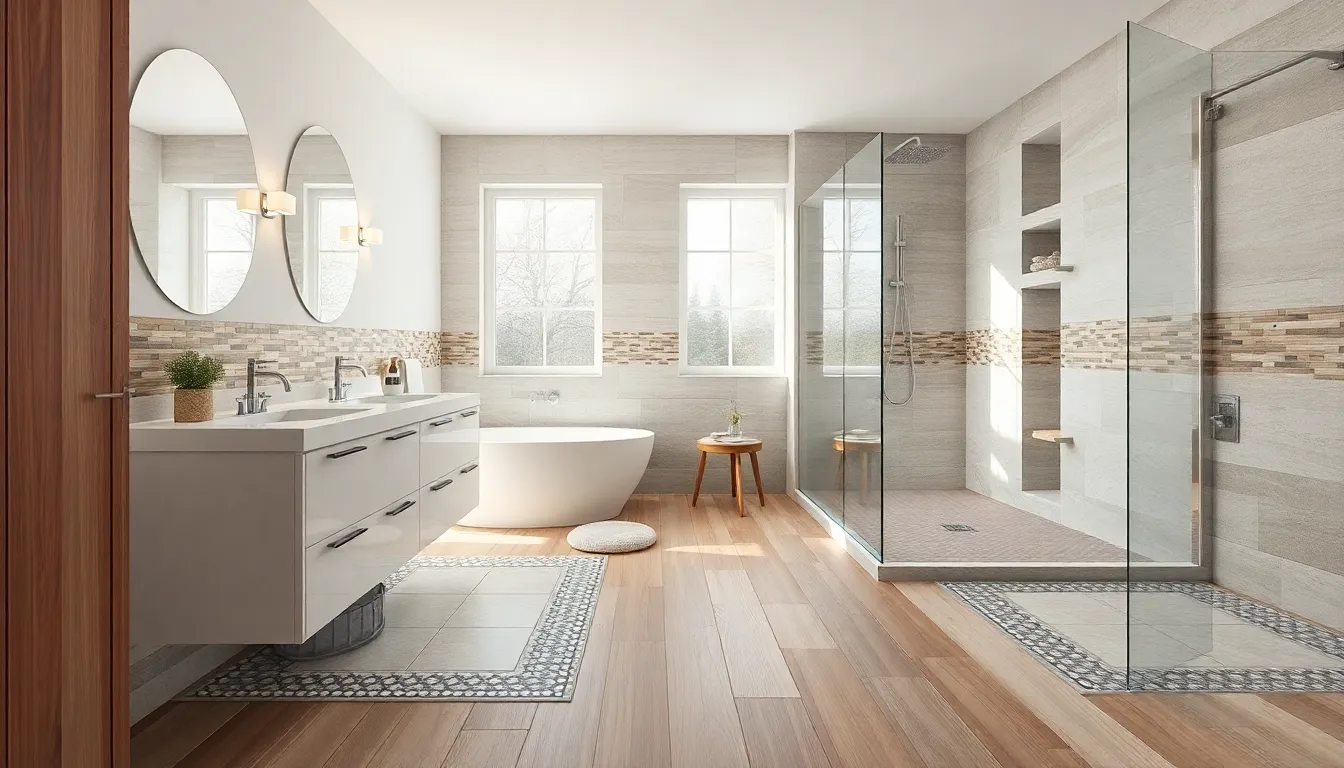
We can create stunning bathroom designs by combining different flooring materials like ceramic, porcelain, natural stone, and wood-look tiles. Mix-and-match strategies open up endless possibilities for customization and visual interest.
Transition Strips and Border Design Ideas
Transition strips create seamless connections where two different flooring materials meet, ensuring both safety and aesthetic appeal. Professional installations use these strips to prevent tripping hazards while maintaining clean lines between materials.
Border designs offer an elegant way to frame your primary flooring material using contrasting colors or patterns. Mosaic borders can outline the perimeter of your bathroom floor, adding decorative elements without overwhelming the space. Penny tile borders work particularly well around vanity areas or shower entrances, creating defined zones through visual contrast.
Pattern combinations like pairing large-format tiles with smaller accent pieces create sophisticated looks. Designers often use limestone paired with penny tiles or combine ceramic and porcelain materials for both durability and style. These contrasting elements help define different functional areas while maintaining overall design cohesion.
Zone-Based Flooring for Large Bathroom Spaces
Large bathroom spaces benefit significantly from zone-based flooring approaches that define exact functional areas. Different tile sizes or materials can mark distinct zones like shower areas, vanity spaces, or soaking tub surrounds.
Stone tiles work exceptionally well in main traffic areas, providing durability and elegance. Mosaic tiles excel in shower zones, offering enhanced slip resistance through increased grout lines. This combination creates both functional benefits and visual appeal by clearly marking different uses within the bathroom.
Texture variations between zones add depth and interest to spacious bathrooms. Smooth porcelain planks might cover the main floor, while textured natural stone defines the shower area. These material transitions help organize large spaces into manageable, purpose-driven sections.
Cost-Effective Partial Coverage Strategies
Partial coverage strategies maximize style impact while managing renovation budgets effectively. Premium materials can be installed only in high-visibility areas like vanity surrounds or shower floors, while more affordable options cover the remaining space.
Accent installations using penny tiles or decorative borders create focal points without covering entire floors. Budget-friendly ceramic or vinyl planks can handle the main flooring area, reducing overall project costs. This approach allows homeowners to achieve designer looks at significantly lower price points.
Strategic placement of expensive materials in areas where they’ll have the most visual impact delivers maximum return on investment. Shower floors might feature natural stone mosaics, while the main bathroom area uses ceramic tiles that complement the premium materials. These partial coverage techniques prove that thoughtful design can overcome budget constraints.
Conclusion
We’ve explored an impressive range of bathroom flooring options that cater to every style preference budget and practical need. From timeless ceramic tiles to innovative waterproof laminate each material offers unique advantages that can transform your bathroom experience.
The key to selecting the perfect flooring lies in balancing your aesthetic vision with your household’s exact requirements. Whether you prioritize comfort with heated systems safety with slip-resistant rubber or luxury with natural stone there’s a solution that fits your lifestyle.
Remember that the best bathroom floor is one that serves your family well for years to come. Consider factors like maintenance requirements installation complexity and long-term durability when making your final decision. With proper planning and installation your new bathroom flooring will provide both beauty and functionality for decades ahead.
Frequently Asked Questions
What are the most popular bathroom flooring materials?
The most popular bathroom flooring materials include ceramic and porcelain tiles, luxury vinyl plank (LVP), natural stone (marble, travertine, limestone), waterproof laminate, and concrete. Each offers different benefits – tiles provide durability and water resistance, LVP combines style with waterproof technology, natural stone offers elegance, laminate provides affordable wood-look alternatives, and concrete delivers modern industrial aesthetics.
Are porcelain tiles better than ceramic for bathrooms?
Yes, porcelain tiles are generally better for bathrooms due to their superior water resistance and durability. While both materials can withstand daily foot traffic and temperature fluctuations, porcelain’s lower water absorption rate makes it ideal for high-moisture environments. Both options offer excellent design versatility and can last 20-30 years with minimal maintenance.
Is luxury vinyl plank waterproof for bathroom use?
Yes, luxury vinyl plank (LVP) features advanced waterproof technology that makes it ideal for bathrooms. The waterproof core prevents water from seeping between planks, handling constant moisture exposure effectively. LVP also provides comfort underfoot and offers realistic wood-look and stone-look designs without the maintenance concerns of natural materials.
How much maintenance do natural stone floors require?
Natural stone floors require regular maintenance including periodic sealing to protect against moisture and staining. You’ll need to use stone-specific cleaners and avoid harsh chemicals. While marble, travertine, and limestone create sophisticated spaces, they demand consistent care practices. With proper maintenance, natural stone floors can last decades while maintaining their beauty and value.
Are heated bathroom floors worth the investment?
Heated bathroom floors provide luxurious comfort and energy-efficient warmth through radiant heat systems. Electric systems offer lower installation costs and quick heating, ideal for smaller bathrooms. Hydronic systems have higher upfront costs but lower long-term energy consumption, better for larger spaces. The choice depends on your bathroom size, usage patterns, and budget considerations.
Can you install waterproof laminate flooring yourself?
Yes, waterproof laminate flooring is DIY-friendly with straightforward floating floor installation systems. The planks typically click together without requiring adhesives or nails, making it accessible for homeowners. This significantly reduces labor costs compared to traditional tile installations. However, ensure proper subfloor preparation and follow manufacturer guidelines for best results.
Is concrete flooring suitable for bathrooms?
Yes, concrete flooring works well in bathrooms when properly finished and sealed. It offers an industrial chic aesthetic with various customization options including staining and different finish levels. Textured coatings provide slip resistance, while specialized sealants protect against moisture and staining. Proper installation and sealing are crucial for durability in wet environments.
What are the benefits of penny tiles in bathrooms?
Penny tiles and mosaics offer enhanced slip resistance due to increased grout lines, improved drainage in shower areas, and flexibility for intricate artistic designs. The small-scale format allows for creative patterns like herringbone and checkerboard. However, they require proper grout sealing and regular maintenance to prevent moisture absorption and maintain integrity.
Is cork flooring good for bathrooms?
Cork flooring can work in bathrooms with proper sealing and ventilation. It offers natural antimicrobial properties that inhibit mold and bacteria growth, plus insulation and sound-dampening benefits. Cork is eco-friendly and comfortable underfoot. However, it requires proper moisture protection and regular maintenance to prevent water damage in high-humidity environments.
How do you combine different flooring materials in one bathroom?
You can combine materials using transition strips for seamless connections, border designs with contrasting colors or patterns, and zone-based strategies for large bathrooms. Use different tile sizes or materials to define functional areas. Consider cost-effective partial coverage by placing premium materials in high-visibility areas while using budget-friendly options elsewhere.

